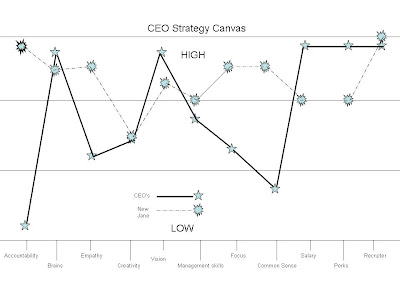
'Blue Ocean Strategy' is a book written by Chan Kim and Renee Mauborgne.
It's good. Like a lot of strategy books, it has useful tools for strategizing and visualizing strategies.
The key thrust of Blue Ocean Strategy is that there are two strategy streams - red ocean strategies for companies competing head-on in existing market spaces (strategy for losers) - and blue ocean strategies for recreating the market space and avoiding competition all together (where real winners come from).
Cirque du Soleil, Canada's circus theater company, is used as a center-piece example. Flush the expensive elephants and tigers, develop a theme, move to multiple venues in Vegas, jack the ticket prices and....voila - the non-circus, circus that's very, very successful.
When I come across intriguing new concepts like this, I like to try them on simple stuff (perhaps the only stuff) I know.
Like me.
This really isn't what the authors of the book had in mind when they wrote the book. They were thinking businesses, not people. But why not? I have a business.
Applying the Blue Ocean strategy to me the consultant and executive coach was a little confusing. Where I seemed to net out is that I probably need to up the process a bit, move to Africa and dye my hair blue. You'll see any changes in my updated profile.
Given the success of defining my own strategy better, I decided to move on to stuff I know way more about - other people's strategies. Like CEO's....keeping in mind that some of my best friends are CEO's.
The Blue Ocean Strategy goes like this.
First, define the key characteristics that make up the existing strategies for this 'industry'.
I defined the key characteristics of the CEO industry this way:
- brains
- determination
- empathy
- creativity
- vision
- management skills
- focus
- common sense
- salary
- perks
- friend who's a recruiter
Then, these elements are mapped on a strategy canvas. Like this.

Next, if you're an individual CEO (or business), you'd map your own 'strategy canvas'.
Let's take Jane, a hypothetical CEO.

Jane has:
- lots brains (see Jane on Jeopardy)
- lots of determination (see Jane work 20 hour days)
- big salary (see Jane drive a BMW)
- strong empathy (see Jane differentiate herself)
- modest creativity (see Jane surround herself with 24 year olds)
- OK management skills (ding, ding, ding)
- zero focus (see Jane multi-task)
- no common sense (see Jane blow-up)
- a very good recruiter friend (see Jane run e-Bay)
But, if Jane were to keep going, what else could she do to come up with a Blue Ocean Strategy for herself and escape the reaches of those other CEO types?
According to Kim and Mauborgne, Jane would figure out the following:
- what factor the CEO industry takes for granted that should be eliminated (like Cirque's tigers and elephants)
- what factors to reduce way below the industry standard (like the circus' fun, humor, thrills, danger)
- what factors to raise way above the industry standards (Cirque's unique venues)
- what factors to create, that the industry has never offered (Cirque's themes)
- the industry takes for granted that Jane will get a big salary; Jane could eliminate that and be compensated purely for performance
- Jane could reduce the following factors way below industry standards: her vision and other perks
- Jane could raise the following above industry standards: her focus, management skills and common sense
- Jane could create the following that the industry has never offered: accountability.

Jane could be FANTASTIC.
She could be a CONSULTANT.
With apologies to my CEO friends (and the authors) tools like this take time to use right. I'm not there yet. I've tried in real business situations also.
I'm working on it. When I get there, I'm going to develop a Blue Ocean Strategy, for strategy.


No comments:
Post a Comment